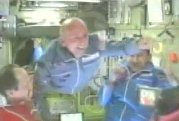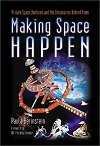|
Activism,
Investing:
NewBusinesses,
RLVs
Private
Space
The
action beneath the radar...

NASA: Where in the world did this guy come
from?
When the Wall Street Journal
first reported in June of 2000 on Dennis Tito's plans to go
to Mir, most people at NASA and in the aerospace industry
were taken completely by surprise.
To them the article might just
as well have said that Tito was going to take a flying saucer
to the orbital station as to suggest
that an obscure activist group and a small startup company
could arrange such a trip.
In fact, to this day many NASA
managers still have a deer in the headlights look when
confronted with questions about the ongoing space tourist
excursions. Small private companies running genuine businesses
in space simply do not fit in their universe.
Space Activism
Spawns Space Companies
A few people, though, were well
aware of attempts to get space tourism and other enterprises
off the ground. Those that belonged to space activist organizations
or just followed developments via the web knew about all sorts
of crazy and not so crazy space proposals and projects.
As reported in the History
of Space Activism section, private efforts to promote
space development have been going on since the beginning of
the 20th century. Much of the progress in early rocketry development
came from amateur rocketry clubs and lone inventers like Robert
Goddard.
The huge Apollo program, however,
convinced the public that nothing significant could be accomplished
in space by small private organizations. NASA and space became
equivalent and only NASA could do great things there.
Activists, however, became more
and more frustrated with NASA's failure to build on the success
of Apollo and to develop a true spacefaring infrastructure
accessible to everyone. The shuttle, for example, became a
huge economic fiasco, making space even more expensive to
reach than ever.
In response, many activists began
to look at the possibilities of carrying out their own space
projects and forming their own companies. The Lunar
Prospector, for example, was born as an activist
project. Many of the startup RLV
companies that arose in the late 1990s were composed
of people who were passionate about personally going to space.
For example, Rick Tumlinson,
a long time space activist, helped to create the Space
Frontier Foundation with the assistance of the telecommunication
magnate Walt
Anderson as a way to promote space enterprises.
Tumlinson was the one who first approached Dennis Tito about
going to Mir. The company MirCorp,
also funded by Anderson, began the arrangements with the Russian
Space Agency. Though Mir was deorbited before Tito got a chance
to visit, the ball was rolling and he was able to switch his
destination to the ISS with some help of another small company
- Space Adventures (not affiliated with Anderson or Tumlinson.)
What's Going
On?
So there has been a lot of space
ferment going on beneath the radar of NASA and most of the
media. To find out more about "private space", there
is a new book out that I recommend.
For an excellent review of the
history of space activism and business development and a survey
of what is happening now, read the book Making
Space Happen (Amazon commission link) by Paula
Berinstein
 Making
Space Happen:
Private Space Ventures and the Visionaries Behind
Them by Paula Berinstein,
2002, Amazon Making
Space Happen:
Private Space Ventures and the Visionaries Behind
Them by Paula Berinstein,
2002, Amazon
"Most Americans equate space exploration with NASA, but
the general public is largely unaware that hundreds of passionate
individuals and private organizations are working to allow
ordinary people the opportunity to tour near space and to
create permanent human settlements on Mars and other celestial
bodies. Through a series of fascinating interviews, this book
introduces the scientists, astronauts,
engineers, and entrepreneurs behind the private space movement
and offers a clear-eyed assessment of their prospects for
success. " - Amazon
She interviews many of the leaders in space
activism and private space business such as Tumlinson, Jim
Benson of Spacedev,
Peter Diamandis of the X
Prize, Robert Zubrin of the Mars
Society, and several others.
Final
frontier beckons as a development opportunity By Paula Berinstein
- Orlando Sentinel - June.23.02
Though I have quibbles about some of the details
in the book, I'm very impressed with the depth of its coverage
of the diverse entrepreneurial space world. I've often
lamented that so few people are aware of the exciting new
developments in space businesses that are occuring with little
attention paid by the mainstream media, as well as much of
the aerospace media.
People in the field like to compare the situation
to that of the early days in the development of personal computers.
In the 1970s such machines were considered hobbyist toys and
even well into the 1980s few of the mainframe computer companies
took PCs seriously. But gradually their capabilities grew
until PCs dominated the industry.
Space tourist jaunts to the ISS, sub-orbital
rocket projects, low cost Moon
orbiters, space
advertising, and other such baby steps at building
a genuine space industry are not taken very seriously today
by NASA and the aerospace giants. While there will surely
be many disappointments and reversals, and it probably won't
grow as fast as the PC business, the tremendous energy, drive
and imagination of the activists and entreprenours will keep
the private space industry alive and expanding.
For more about private space developments,
check out David Livingston's The
Space Show. This weekly radio show, previously known
as Business Without Boundaries, is now available on
line. He interviews leading figures in the development of
outer-space commerce and space tourism. Archives of shows
since June 2001 are also available. Listen
live on the internet at www.renaissanceradio.com
.
Mike
Hodel's Hour 25 is primarily devoted to science fiction
but he also often has space activists as guests. See the list
of previous
shows (Index
by Guest ) that are available on line.
Finally, there are many sections here at HobbySpace
that monitor events in activism and the new space businesses.
For example, see the Space
Activism, Investing:
New Businesses,
RLV
Countdown and the RLV
News sections. See also the review of the recent
Space
Access Society Conference where many RLV companies
discussed their projects.
|




